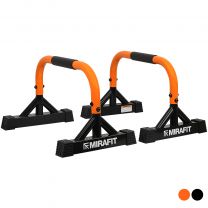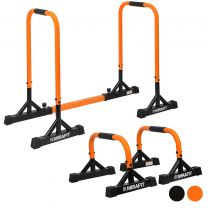Calisthenics to Build Muscle
Calisthenics to Build Muscle

You’ve mastered the calisthenics for beginners, what’s next? Luckily for you it doesn’t stop there. Calisthenics training can be as easy or as difficult as you want it to be. The body is the ultimate tool for resistance training and there’s always a way to take things to the next level.
This article is for anyone that has been consistently practicing calisthenics and wants to challenge themselves by progressing to more advanced movements. We’ll give you some tips on how to increase the difficulty of your training, as well as 5 key calisthenics movements that will put your body to the test.
How Do You Make Calisthenics More Difficult?

Include Additional Weight
Although calisthenics exercises are known to be bodyweight movements, you can make them more difficult by including additional equipment. Parallettes can be used for more advanced calisthenics movements such as V-holds, handstand push ups and dips.
Another option is to incorporate weights into your movements. Although for the most part, calisthenics is a style of bodyweight training, you can load the body with weight plates to increase the difficulty of exercises. For example, you can load plates onto your back to add more weight to a push up, or use a Weight Belt with Chain to add resistance to pull ups and dips.
Slow Down
Another way to progress your calisthenic movements is by slowing down. Take your time holding the poses as it means that your muscles are spending more time under tension and therefore making the exercise harder.
Sometimes people can tend to rush through movements and as a result you use momentum to get yourself into the positions rather than muscular strength. By slowing down you can be sure that you’re executing the exercises correctly.
Combine Exercises
One of the unique traits of calisthenics is that you can combine movements to make them more difficult. Once you become more comfortable with each exercise you can begin transitioning straight from one to the other. For example, you can transition from a muscle up through into a front lever, or a handstand into a handstand push up. Not only does this increase the difficulty, but it also allows you to be more creative with your training.
Advanced Calisthenics Movements

Planche
The planche is one of the fundamental calisthenic movements. Even if you aren’t ready to maintain a full planche, you can perform a tuck planche which still builds strength in the shoulders and wrists. As well as this, once you’ve mastered the exercise, it will help build the foundations for other hand balancing movements such as handstands and front levers.
Handstand Push Ups
First things first, before you tackle a handstand push up you need to make sure you can complete both push ups and handstands proficiently with full range of movement. Handstand push ups require a lot of shoulder strength and mobility.
Muscle Ups
Muscle ups are unique because they are one of few movements that include both a push and pull upper body movement. This means that you’re using all of the large muscle groups in your upper body such as your chest, shoulders and back. To work your way up to a muscle up you can do accessory work such as pull ups and dips that will build strength for the different components of the movement.
Dragon Flag
This is by far one of the most advanced core movements in calisthenics and it will take a lot of full body strength and stability before you are able to master it. The dragon flag is so difficult because it requires engagement of all of the muscles in your torso so that you stay stiff when lowering down. Bruce Lee famously incorporated the dragon flag into his training, so you know it’s not for the faint hearted. To start, begin by bending your knees at 90 degrees and work your way up to straight legs.
Front Lever
The front lever is an exercise that has been taken from the world of gymnastics and transitioned into calisthenics. Again, it requires full body strength, but particularly in the upper body and core. When training up to do a front lever you should practise straight arm movements such as a high plank and other isometric holds.
Like with any type of training, calisthenics takes consistency, and a lot of patience. You might only be able to hold a wall handstand now, however, with a few months of persistent training a handstand push may be within reach.
Written by guest author Eryn Barber.
For more content, follow us on Instagram, YouTube, TikTok, and on our official Mirafit Facebook page.
Enter your email to signup to our newsletter







